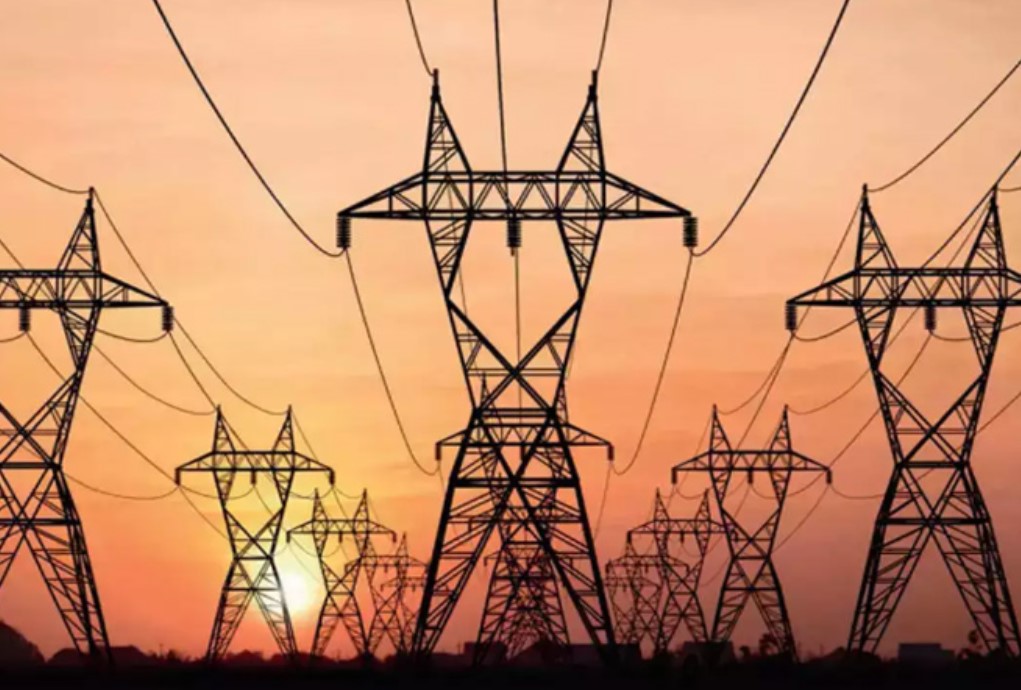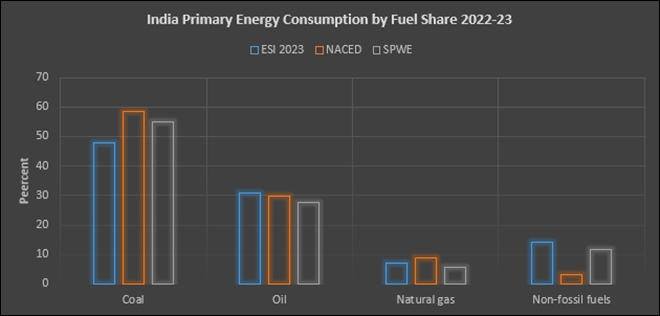-
CENTRES
Progammes & Centres
Location
A 10-percent difference in estimating India’s annual carbon emissions can shift India’s position from the right side of climate action to the wrong side.

This article is part of the series Comprehensive Energy Monitor: India and the World
There are several excellent sources of data and information on segments of the energy sector in India. For example, the Central Electricity Authority (CEA), the Central Electricity Regulatory Commission (CERC) and Grid-India provide most of the data and information required on the electricity sector. The Petroleum Planning And Analysis Cell (PPAC) provides detailed data and information on the petroleum sector. The ministries of power, coal, petroleum & natural gas, renewable energy and related departments provide valuable data through interactive dashboards. The annual publication, Energy Statistics India brought out by the Ministry of Statistics & Programme Implementation of the Government of India collates data from CEA, CERC and PPAC along with data from energy-related ministries and institutions. More recently NITI Aayog, the in-house government think-tank, has launched a climate and energy dashboard. While the proliferation of data sources on energy supply and demand in India is positive, the absence of a central agency that collates available data and presents it in harmonised units and measures is a challenge that remains to be addressed. Inconsistency and incompatibility between domestic data sources and also between domestic and international sources make conversations on energy developments in India inaccurate.
Energy Statistics India 2023 (ESI 2023) as well as NITI Aayog’s Climate and Energy Dashboard (NACED) carry data on India’s primary energy consumption basket. According to ESI 2023, coal accounted for 48 percent of India’s primary energy consumption of 33,508 petajoules (PJ) [33.5 exajoules EJ], oil 31 percent, natural gas 7 percent and non-fossil fuels (nuclear, hydro and renewable energy [RE]) 14 percent in 2021-22. The use of unprocessed biomass (firewood, animal dung, agricultural waste) by households as energy for cooking is not included in the ESI 2023 data.
Inconsistency and incompatibility between domestic data sources and also between domestic and international sources make conversations on energy developments in India inaccurate.
According to the NACED, coal accounted for 58.33 percent of India’s primary energy consumption of 753 million tonnes of oil equivalent (mtoe) [31.5 EJ], oil 29.66 percent, natural gas 8.95 percent and non-fossil fuels (nuclear, hydro and RE) 3.06 percent in 2022 (calendar year). The break-up for energy derived from non-fossil fuels is specified by NACED with hydropower at 1.68 percent of India’s total primary energy, RE at 0.89 percent and nuclear at 0.49 percent. NACED explicitly states that unprocessed biomass is not included and that the sources for the energy data are almost entirely government ministries and institutions.
According to the Statistical Review of World Energy 2023 ([SRWE], formerly British Petroleum [BP] statistical review of world energy), coal accounted for 55.1 percent of India’s primary energy consumption of 36.44 EJ in 2022 (not including unprocessed biomass), oil 27.6 percent, natural gas 5.7 percent, RE 5.9 percent, hydro 4.5 percent and nuclear 1.15 percent.
According to the International Energy Agency (IEA), coal accounted for 44 percent of India’s primary energy consumption of 27.5 EJ in 2021, oil 24 percent, unprocessed biomass 21 percent, natural gas 6 percent, non-fossil fuels 4 percent of which hydropower accounted for 2 percent, RE and nuclear energy 1 percent each. Data for 2021 from the IEA cannot be used for comparisons as 2021 was a pandemic year during which energy consumption fell dramatically. The IEA is yet to publish data for 2022.
The data for installed capacity for power generation and generation of power is more consistent than the data for primary energy consumption. Both the domestic sources ESI 2023 and NACED use data from the CEA. However, there is a difference of 240 TWh for annual power generation in 2022 between NACED data and SRWE. The use of the financial year 2022-23 by NACED and calendar year 2022 by SRWE could explain some of the deviations but not all of them. There are small differences in the data for the share of fuels in power generation across the various domestic and international sources but these are close enough to be ignored. Broadly coal accounted for about 73.07-74.28 percent of power generation, oil & gas about 1.4-2.6 percent, nuclear 2.49-2.83 percent, hydro 9.41-10.02 percent and RE 11.08-11.44 percent in 2022-23.
The data for installed capacity for power generation and generation of power is more consistent than the data for primary energy consumption.
The difference between the values for India’s primary energy consumption is too large to be ignored. For example, the value for India’s primary energy consumption in 2022 estimated by ESI 2023 (domestic source) is at least 8 percent lower than the estimate by SRWE (international source) and that of NACED is almost 15 percent lower than SRWE. The value of the energy efficiency of the Indian economy which is among the key quantitative targets in India’s commitment to the Paris Agreement critically depends on the data used. The inclusion or exclusion of biomass as fuel for cooking in primary energy consumption can also significantly alter the estimation of the Indian economy’s energy efficiency. Energy efficiency is the energy required to produce one unit of GDP (gross domestic product), and the inclusion of biomass will increase India’s energy consumption and consequently decrease India’s energy efficiency.
The estimates for the share of coal in India’s primary energy consumption by SRWE, an international source is almost 14 percent higher than that of domestic sources. The difference in estimates for the quality or calorific value of coal could explain some of the difference. Data for coal consumption is significant in the context of the call for coal phase-down in multilateral climate negotiation platforms. The estimates for the share of natural gas consumption in India’s primary energy basket by NACED is almost 50 percent higher than that of SRWE for 2022-23. According to domestic data, India has moved closer to the target set by the Government of India to increase the share of natural gas in India’s primary energy basket from about 6 percent in 2016 to 15 percent by 2030. However, according to international data, India has slipped in its goal to increase the share of natural gas in its primary energy consumption. The share of non-fossil fuels in India’s primary energy consumption basket as given by the two domestic sources differ by over 75 percent. Such a large deviation needs a clear explanation or correction. The share of non-fossil fuels in a country’s energy consumption is now an important metric in evaluating the climate mitigation efforts of the country. Under-estimation of the share of non-fossil fuels in primary energy consumption can undermine India’s efforts towards decarbonisation.
The estimates for the share of natural gas consumption in India’s primary energy basket by NACED is almost 50 percent higher than that of SRWE for 2022-23.
The ambiguity in quantitative measures for energy consumption can lead to qualitative consequences. Data uncertainty can conceal real gains made in energy efficiency and it can lead to confusion over absolute decline in coal use. At the extreme, uncertainty over assumptions (such as heating value, carbon content etc) behind estimates for the quantity of coal used by India can lead to overestimation of India’s carbon emissions. A 10-percent difference in estimating India’s annual carbon emissions can shift India’s position from the right side of climate action to the wrong side.

Lydia Powell is a Distinguished Fellow at the Observer Research Foundation.
Akhilesh Sati is a Program Manager at the Observer Research Foundation.
Vinod Kumar Tomar is a Assistant Manager at the Observer Research Foundation.
The views expressed above belong to the author(s). ORF research and analyses now available on Telegram! Click here to access our curated content — blogs, longforms and interviews.

Ms Powell has been with the ORF Centre for Resources Management for over eight years working on policy issues in Energy and Climate Change. Her ...
Read More +
Akhilesh Sati is a Programme Manager working under ORFs Energy Initiative for more than fifteen years. With Statistics as academic background his core area of ...
Read More +
Vinod Kumar, Assistant Manager, Energy and Climate Change Content Development of the Energy News Monitor Energy and Climate Change. Member of the Energy News Monitor production ...
Read More +